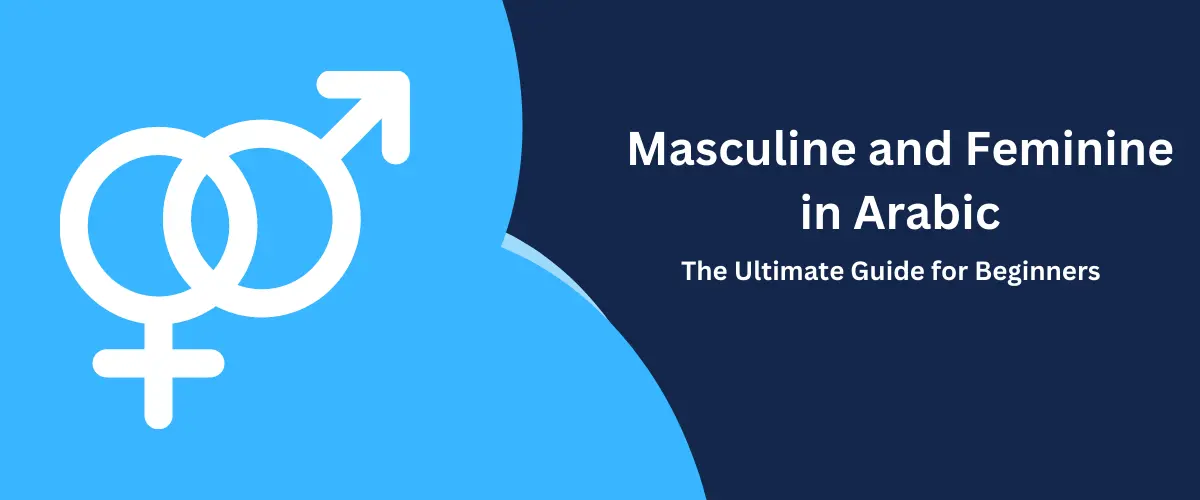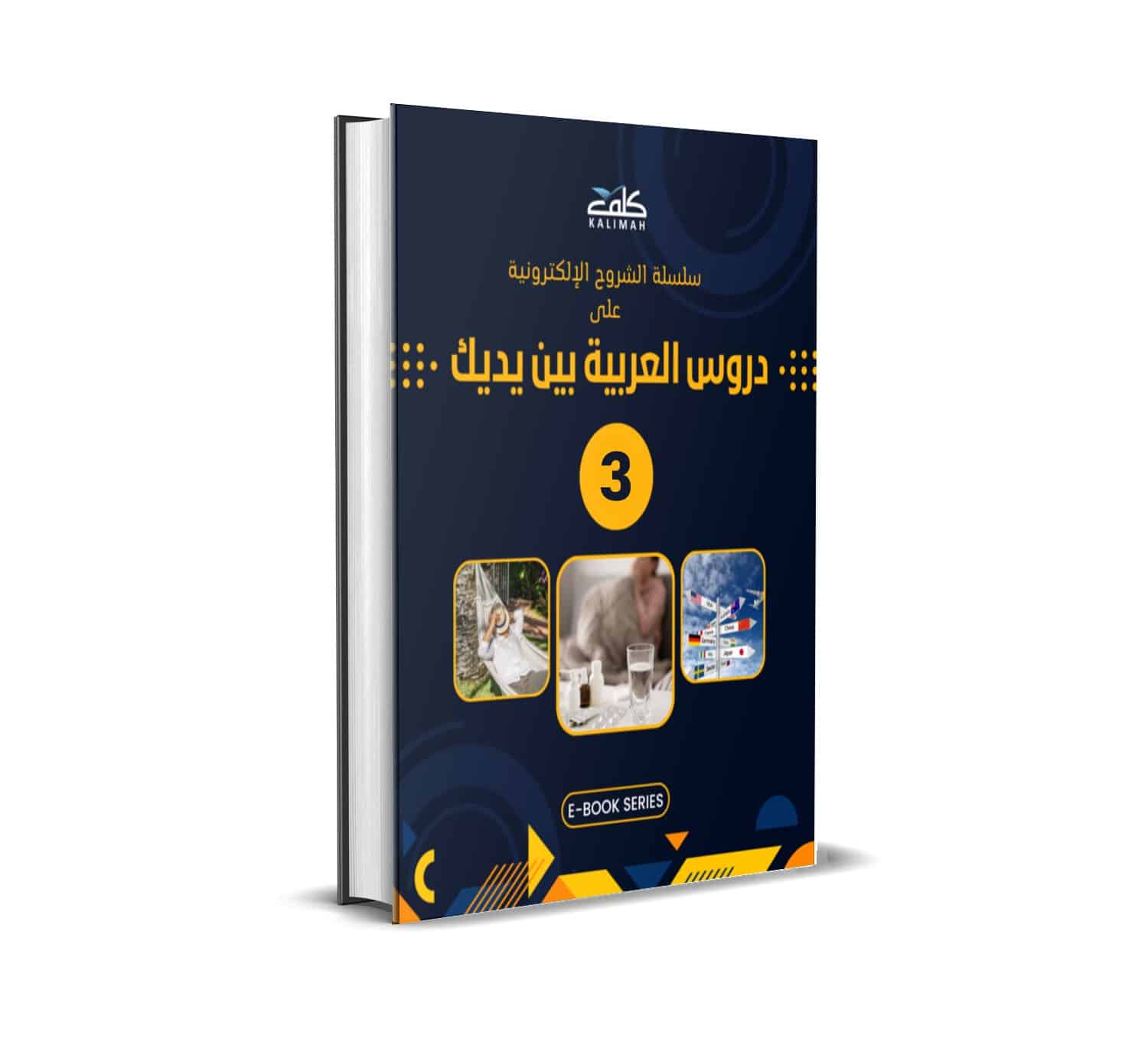In Arabic grammar, nouns, adjectives, and pronouns are separated into two genders: masculine and feminine. This rule is fundamental to the language and plays an important part in forming sentences.
Some languages can define gender based on the natural gender of an object or living thing, but the gender in the Arabic language is regularly arbitrary and not always linked to biological gender. To put it differently, objects or concepts that are feminine in other languages may be masculine in Arabic, and vice versa. It sounds a bit challenging, but don’t be concerned; we’ll walk you through it step by step. So, let’s start the journey of masculine and feminine in Arabic.
What is masculine in Arabic?
“Masculine” in Arabic describes nouns that either indicate males or don’t necessarily have any inherent gender but are grammatically classified as masculine. For instance, the word رَجُل (rajul) means “man” and is naturally masculine. However, the word مَكْتَب (maktab) meaning “table” is also considered masculine in the language, not because tables are linked to men, but because of the linguistic classification within Arabic grammar
Types of masculine in Arabic
We have two types of masculine:
- Real Masculine: This type indicates the gender of living things, such as men and male animals. For example, وَلَد”walad” (boy), رَجُل “rajul” (man), حِصَان”hisan” (horse).
- Unreal Masculine: This indicates the gender of non-living things or abstract nouns. In Arabic, if something is not especially feminine, it is considered masculine. For example, كِتَاب”kitab” (book),قَلَم “qalam” (pen), etc. All of them are unreal masculine as they do not have a natural sex but are treated as masculine in the language.
Here are other examples for Masculine
| Type of Masculine | Example | Meaning |
| Real Masculine | وَلَد (walad) | boy |
| رَجُل (rajul) | man | |
| حِصَان (hisan) | horse | |
| أًسَد (asad) | lion | |
| Unreal Masculine | كِتَاب (kitab) | book |
| قَلَم (qalam) | pen | |
| مَنْزِل (manzil) | house |
What is Feminine in Arabic?
Feminine is an adjective that is used to describe nouns that indicate females, objects that are recognized as having female characteristics, or concepts that are linked to femininity. For example, the word امْرَأَة (imraah) “woman” is feminine. The word (warda) “flower” وَرْدَة is also feminine. This is because flowers are commonly seen as being linked to women.
Types of Femininity in Arabic
In Arabic, we have three types of femininity:
- Real Feminine: This indicates the gender of living things that are biologically female. Femineity refers to female humans and animals. For example, بِنْت”bint” (daughter),أُمْ “umm” (mother), نَعْجَة”na’ja” (female sheep) etc.
- Unreal Feminine: This indicates the gender of non-living things or abstract nouns that are linguistically indicated to as feminine, even though they are not biologically female. For example, شَمْس’shams’ (sun) or أَرْض’ard’ (earth) are feminine in Arabic.
- Marked Feminine: This type of femininity the word is Masculine, but it has a sign of feminine gender such as “taa’ marbuta” (ة). For example, حَمْزَة’Hamza’ (name of boy). We also have other signs of feminine gender like alif at-tanith al-maqsurah: ـ (ى), for example: كُبرَى (koubra). Alif at-taniith al-mamdudah: (اء / ـاء) is other sign, for example: حَمْرَاء(hamraa).
| Type of Feminine | Example | Meaning |
| Real Feminine | بِنْت (bint) | Daughter |
| أُمْ (umm) | Mother | |
| نَعْجَة (naa) | Female Sheep | |
| عَرُوس (arus) | Bride | |
| Unreal Feminine | شَمْس (shams) | Sun |
| أَرْض (arḍ) | Earth | |
| حقيقة (ḥaqiqah) | Truth | |
| Marked Feminine | حَمْزَة (ḥamzah) | Name of Boy “Hamza” |
| كُبرَى (koubra) | Greatest | |
| عَمْيَــاء(amiaa) | blind |
Masculine and Feminine Grammatical Rules in Arabic
Here are some of the grammatical rules for masculine and feminine in Arabic:
Nouns: Masculine nouns usually end in a consonant. Feminine nouns usually end in a (ta marbuta) (ة). There are a few exceptions to this rule, such as the noun شَمْس (sun), which is feminine even though it ends in a consonant.
Adjectives: Adjectives agree with the gender of the noun they modify. For example, the adjective جَمِيل (beautiful) is masculine, and the adjective جَمِيلَة (beautiful) is feminine.
Pronouns: Pronouns also agree with the gender of the noun they indicate to. For example, the pronoun هو (he) is masculine, and the pronoun هي (she) is feminine.
Examples of masculine and Feminine Nouns
Masculine Nouns:
رَجُل (rajul) – man
وَلَد (walad) – boy
طَبِيب (tabib) – doctor
كِتَاب (kitab) – book
بَيْتٌ (baytun) – house
كُرْسِيٌّ (kursiyyun) – chair
Feminine Nouns:
امْرَأَة (imraah) – woman
بِنْت (bint) – girl
مُمَرِضَة (mumarridah) – nurse
مَدَرَسَة (madrasah) – school
زَهْرَة (zahrah) – flower
مَدِينَة (madinah) – city
How to differentiate the masculine from Feminine words
Here are a few key tips that will help you to differentiate between masculine and feminine words:
- The ending of the word: Most masculine nouns end in a consonant, while most feminine nouns end in a ta marbuta (ة), but there are exceptions to this rule. For example, the word شَمْس (sun) is feminine even though it ends in a consonant.
- Context: The context of the sentence can sometimes give you signs about the gender of the noun. For example, if a sentence is talking about a female person, it’s likely that the noun indicating that person will be feminine.
- Learn nouns with their gender: As you learn more Arabic vocabulary, you’ll know the gender of different nouns. Pay attention to the articles and patterns used with them.
- Practice and exposure: Reading, listening, writing, and speaking will help you develop your skills to know the gender.
- Memorizing: Memorizing is a good idea, especially for nouns that may not follow regular rules.
Looking up the word in a dictionary or asking a native Arabic speaker may help you to know the gender.
Inflecting for Femininity
For the singular, we consider the noun feminine if it has one of the three signs:
- A round Taa (ة) at the end of the noun.
- Alif at-tanith al-maqsurah: (ى)
- Alif at-taniith al-mamdudah: (اء / ـاء).
| Example | Translation | Pronunciation |
| دَرّاجة | bicycle | darajah |
| كَراهة | dislike | karahah |
| بَقَرَة | cow | baqraa |
| صُغْرَى | smaller | sougra |
| سَمَاء | sky | samaa |
For dual feminine, we add the suffix “-ان” (ann) to the end of the word, for example, بِنْت(bent) will be بِنْتَان(bentan).
For the plural,
To make a feminine noun plural in Arabic, we add the suffix “-ات” (-aat) to the end of the noun. For example,” دَرّاجة ” (bike) becomes “ دَرّاجات ” (bikes).
Broken Plurals: Broken plural is other type of plural in feminine and masculine. This type does not have a simple rule that you can follow. So, you need to memorize them or learn them from context for example, عَيْن (ayn) with the broken plurals will be أَعْيُن (ayon).
FAQs
How do you know if a word is masculine or feminine in Arabic?
Here are some ways to know if a word is masculine or feminine in Arabic:
The ending of the word: Most masculine nouns end in a consonant, while most feminine nouns end in a ta marbuta (ة) or other signs of feminine such as alif at-tanith al-maqsurah: ـ (ى), for example, كُبرَى (koubra). Alif at-taniith al-mamdudah: (اء / ـاء) is other sign, for example: حَمْرَاء(hamraa). However, there are exceptions to this rule. For example, the word شَمْس (sun) is feminine even though it ends in a consonant.
The meaning of the word: In general, nouns that indicate males are masculine, while nouns that refer to females are feminine. For example, the word أَحْمَد (Ahmed) is a name for a male, so it’s a masculine. The word كِتَاب (ketab) which means (book) indicates to a male, so it’s masculine. Otherwise, the word بٍنْت (bent) which means (a girl) refers to a female human, so it’s feminine. If you find any difficulties in knowing the meaning of a word, you can look it up in the dictionary or ask a native speaker.
The context in which the word is used: If a noun is used with a feminine adjective or pronoun, then it is feminine. For example, the sentence الْفَتَاةُ جَمِيلَة (The girl is beautiful) uses the feminine adjective جَمِيلَة (beautiful) with the noun الفتاة (girl), so الفتاة must be feminine. If I say, الْوَلَدُ جَمِيل (The boy is beautiful). We use the masculine adjective جَمِيل (beautiful) with the noun الْوَلَدُ (boy), so الْوَلَدُ must be masculine.
Pronouns: Personal pronouns in Arabic have obvious forms for masculine and feminine. These pronouns can help you determine the gender of the subject or object in a sentence.
Vocabulary: The more you learn Arabic vocabulary, the more you’ll know the gender of commonly used words.
Practice: The more you practice, the more you will master it.
What is masculine gender in Arabic?
Masculine is an adjective that is used to describe nouns that indicate to males, objects that are recognized as having male characteristics, or concepts that are linked to masculinity. For example, the word for “man” is رَجُل (rajul), which is masculine. The word for “table” is مَكْتَب (maktab), which is also masculine, even though it is not referring to a male.
What are masculine nouns in Arabic?
Masculine nouns are nouns that refer to males or things that are treated as males. They can refer to living things, objects, or professions too.
Is Arabic a masculine or feminine language?
Arabic is a grammatically gendered language. It has both masculine and feminine genders. However, I can’t describe the language itself as a masculine or feminine; rather, it’s a grammatical feature of the language’s structure.
What is an example of masculine and feminine gender in Arabic?
Masculine Nouns:
رَجُل (rajul) – man
وَلَد (walad) – boy
طَبِيب (tabib) – doctor
كِتَاب (kitab) – book
بَيْتٌ (baytun) – house
أَسَد (asad) – lion
Feminine Nouns:
امْرَأَة (imraah) – woman
بِنْت (bint) – girl
مُمَرِضَة (mumarridah) – nurse
مَدَرَسَة (madrasah) – school
زَهْرَة (zahrah) – flower
مَدِينَة (madinah) – city
How do you make masculine and feminine plural in Arabic?
Here are some steps help you to make masculine and feminine plural in Arabic:
Masculine plural: For masculine, we usually add the suffix “-ون” (-oon) or “-ين” (-een) to the end of the noun. For example, “مُعَلِم” (teacher) becomes “مُعَلَمُون” (teachers). You add “-ين” (-een) if the noun comes as an object. For example, “معلم” (teacher) becomes ” مُعَلَمُين ” (teachers).
Feminine plural: For feminine, you add the suffix “-ات” (-aat) to the end of the noun. For example,” مُمَرِضَة ” (nurse) becomes ” مُمَرِضَات ” (nurses).
Broken Plurals: Broken plurals in Feminine and Masculine do not have a simple rule that you can follow. So, you need to memorize them or learn them from context. For example, ” رَجُل ” (rajul) becomes “رِجَال” (rejal), and بَيْت (bayt) becomes بِيُوت (beyot).
Which body parts are feminine in Arabic?
Here are some examples of Feminine body parts:
عَيْن (ayn) – eye
يَد (yad) – hand
رِجْل (rijl) – foot
رَأْس (ras) – head
رَقَبَة (raqabah) neck
إِصْبَع (isba) finger
عَضَلَة (adalah) muscle
At the end of this article, you must know that if you need to master the masculine and feminine, you need to practise more and more. The more you read, write, listen, and speak, the more you will be perfect at this rule.
Test yourself.
Read the following passage and put the Masculine or Feminine words in the right place:
ذات يوم في فصل الربيع وكانت الشمس مشرقة والسماء صافية، ذهب محمد للمدرسة لكي يرى أحمد صديقه. تقع المدرسة بجوار الحديقة الكبيرة. وفي الفصل، تعلم احمد ومحمد اللغة العربية. وقد قالت لهم المعلمة: بارك الله فيكم.
| Masculine | Feminine |
How Kalimah Helps You Understand Masculine and Feminine
At Kalimah-center, we understand the nuances of the Arabic language, especially the intricate dance between masculine and feminine forms. Our tailored courses, led by seasoned instructors, simplify and demystify these complexities. If you’re eager to dive deep into Arabic and grasp its subtle distinctions, the Kalimah-center Arabic online course is your go-to. With us, you’re not just learning a language, but immersing in its rich tapestry of culture and history. So, if mastering the masculine and feminine in Arabic is on your list, let Kalimah be your guide. Join us, and let’s explore Arabic together!
💡 Why Choose Kalimah?
Expert Tutors: Learn from native Arabic speakers and Ijazah-certified teachers who prioritize your progress.
Flexible Learning: Enjoy one-on-one classes, 24/7 access to materials, and interactive exercises for a dynamic learning experience.
Comfortable Environment: Benefit from a supportive and encouraging atmosphere, where mistakes are seen as opportunities for growth.
Proven Success: With over 8,000 students worldwide and glowing testimonials, Kalimah Center is your trusted partner in Arabic and Quran education.
🚀 Start Your Free Trial Today! 🚀
Don’t miss out on this life-changing opportunity to deepen your faith and knowledge. Sign up now for your free trial and take the first step towards becoming a better practicing Muslim with Kalimah Center!













